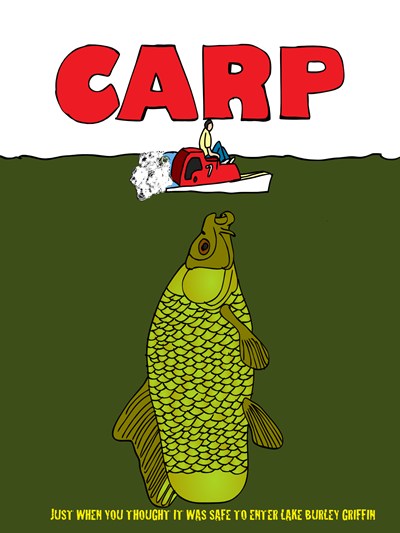Latest News
Lake Burley Griffin serves up a frightful meal of carp
Wednesday, 4 June 2014
“Wow, this tastes surprisingly good for carp. It’s actually quite nice. Wait - it didn’t come from Lake Burley Griffin did it!?”
Earlier this year I wrote a column describing how to prepare carp, based on a method by Keith Bell of K&C Fisheries. I think I managed to convert a few people to the idea of eating this much-maligned fish — but to be honest, the response was mixed. Comments ranged from “Yuk!” to “I’d rather eat my rod, reel, tackle box, boat and trailer”. Another common response was “I wouldn’t eat anything from Lake Burley Griffin”.
Local artist Michael Ashley produced a great piece, with the simple name “Carp”. It shows a person sitting in a hired paddle boat peddling frantically — presumably he is about to be swallowed whole by a gigantic carp lurking underneath. I think it perfectly captures the feelings Canberrans have for both carp and the lake. But are the fears about eating fish from Lake Burley Griffin justified?
Heavy metals
‘The lake’ and the Molonglo River do have a chequered history. A dam collapse at the gold, lead and zinc mine upstream at Captains Flat was blamed for killing all the native fish in the 1940’s. Water with dissolved metals has continued to trickle out of the mine despite its closure in 1962 and remedial works in 1976, although it has slowed. A 1992 study led by Maher sampled carp, the only large fish they caught, from Lake Burley Griffin and found the levels of zinc were extremely low. The National Capital Authority (NCA) says fish from the lake comply with all relevant food standards. Maher did however find moderate levels of zinc in the lake’s sediments, vegetation, algae, mosquito fish and invertebrates. So while (mostly) vegetarian fish like carp should be okay to eat, these findings do raise questions about eating predatory fish, such as redfin, yellowbelly and particularly Murray cod, which would concentrate metals up the food chain. I haven’t been able to find any studies on these fish, but I think it’s probably another good reason to let the big cod go.
Blue-green algae and sewerage
The ‘fragrant’ blue-green algae that has returned is another concern when it comes to eating fish from Canberra’s lakes. But health advice suggests that it’s actually fine to eat fish caught during an outbreak, as long as you wash the fish thoroughly in clean water, and dispose of the organs (because that’s where any toxins will accumulate). Anglers should still keep an eye on advice from the NCA, as direct contact with water during a blue-green algae outbreak can make you sick.
Another part of the ‘eww’ response when it comes to eating fish from Lake Burley Griffin is the thought of bacterial contamination or sewerage spills. Again, if you wash your fish with clean water and make sure it’s properly cooked, this isn’t a problem. However, Burley Griffin Carp Sashimi is probably not a dish you should be serving your family.
Not all carp are created equal
Not all of the responses to the previous column were negative. A few anglers lent their support and added “carp from a clean clear river are surprisingly good”. It might just be hearsay, but carp caught from rivers do seem to smell and taste better than carp from lakes. I went ahead and tried the Keith Bell method for preparing carp a couple of weeks ago and the reaction from the family was entirely positive. I have to admit though, I caught it in the Murrumbidgee river and not Lake Burley Griffin.
So we are assured that eating fish, or at least carp, from Lake Burley Griffin is not something to be afraid of. And an afternoon of fishing in the local lakes is an easy alternative to the coast or mountains. But if you’re targeting something for Sunday dinner, there are sweeter waters not far away.
Tags Lake Burley Griffin carp Blue-green algae Graham Fifield



